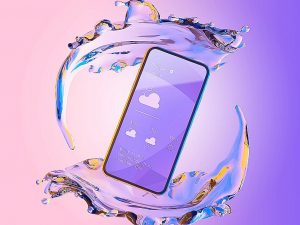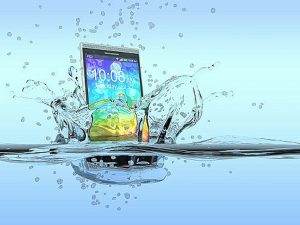What To Do If Water Enters Your Phone: It only takes one slip-up to get water into your phone, whether you’re washing your hands or anywhere close to water. The world seems to stop at that instant as it begins to dawn on you that everything could go from bad to worse within the next few seconds.
According to Data AI, we use our mobile devices for 4.8 hours on average each day. The sheer thought of the possible irreversible damage to such a high-tech device, probably worth a significant amount of money and that contains everything from family portraits to important documents/internet banking can be frightening. It gets even more stressful when you begin to consider how much you may spend to repair or even get an entirely new phone.

Still, It’s not necessarily the end for a device if it gets into water. This article discusses what to do if water gets into your phone.
Recommended: Differences Between British and American English
Water Resistant vs Water Proof Phone
Many phone manufacturers have made their devices water-resistant in recent years. Waterproof, however, is not the same as water resistant. A device is water-resistant if it is graded for water exposure for a given duration and up to a specific depth whereas water-proof means it is impenetrable to water at all times.

An “ingress protection” code, sometimes referred to as an IP rating, is indicative of a phone’s water resistance. In other words, the efficacy of an electrical device against intrusions from solids and liquids is simply referred to as its IP rating.
The IP rating consists of two digits. While the second indicates resistance to liquids, notably water, the first indicates protection against solids like dust. The solid object protection for a phone with an IP-68 certification is 6 (complete protection from dust, dirt, and sand), and the liquid protection is 8 (protected from immersion in water to a depth of more than one metre).
Phones that can withstand water have ratings beginning with “IP6,” followed by the number 7 or 8. (e.g., IP67, IP68). For up to 30 minutes, phones with an IP67 rating may often be immersed in water up to one meter deep. Several smartphones have the IP67 rating, including the Google Pixel 2, iPhone X, and iPhone 8. Phones with an IP68 rating can be immersed for up to 30 minutes in water up to 1.5 meters deep. Samsung Galaxy S7, iPhone XS, iPhone 12 models, iPhone 11 models, and Google Pixel 3 are some examples of smartphones with IP68 ratings.

Also see: Richest Companies in the World
What to Do If Water Enters Your Phone
1. Act Quickly: Your phone’s survival depends on your ability to act quickly. Perhaps the water has not gotten to the vulnerable components. If you act promptly, you can salvage the situation and prevent your phone if not entirely, from significant damage.
The longer you have water in your phone, the less likely the chances of it being saved since the water may penetrate deeper layers and into vulnerable components. So it’s best if you first remove your phone immediately from the water source. After then, even if it is still on and appears to be functioning well, you must quickly proceed with some steps to prevent further damage.
It’s vital to remember that some actions might spell the difference between a phone that’s a total loss and one that is a survival story. So, exercise caution in all subsequent steps you take. Turn off your phone right away, even if it appears to be functional.
Short-circuiting may occur if you leave the phone on. The water insertion can overload the phone with energy, which often electrocutes the circuit board. This can however be prevented If your phone is turned off. Refrain from checking the functionality of your phone by turning it on or activating applications. Try not to press any keys. In fact, avoid using your phone at all. The risk to your phone is further increased when you use it because it pushes the water further in.
So, If your phone has been in water, regardless of whether it is still operational, assume that it is waterlogged and turn it off right away. In addition, unplug the phone’s cable from the outlet if it was connected while submerged. If you don’t first disconnect it, you run the danger of getting electrocuted when taking it out.
Recommended: Differences Between Microeconomics And Macroeconomics
Don’t shake or move the phone around excessively
Water may be forced into the phone’s deeper components, such as its jacks, speakers and ports when you shake or move the phone around excessively. You don’t want water to be flowing about within the phone in actuality, because it could be a risk to the recovery of the phone. Avoid blowing into the gadget as well because it could have similar effects. Remove all phone accessories (protective casing, charger etc).

Gather some paper towels or lint-free clothes as soon as possible, then quickly place your phone on top of them while you remove any connected devices. Anything that is still attached to your wet phone has the potential to become damaged or trap more water inside.
Furthermore, avoid connecting a charger to your phone. You couldn’t be more mistaken if you believe that charging the battery would restore power to a phone that has shut off owing to contact with water. So, using a charger may only worsen the situation.
Disassemble the phone by removing the SIM card and battery (if possible)
Disassembling the phone is another quick action that should be done, but be particularly careful when doing so. Put the SIM cards, SD Card, and battery (if possible) on a dry paper towel after removing them from your phone. Use a soft cloth or cotton to dry up any liquid or moisture seen within the device.

It’s critical to completely dry every part of the phone to prevent water damage to the sensitive components. You must be especially careful when doing this, as was previously stated. If you’re not sure about anything, don’t do it. Put every component that is detachable somewhere dry.
Also see: Best Smartphones For Students 2022
2. Drying Your Phone
Wipe away water using appropriate materials
The best option to wipe down your wet phone is a microfiber cloth if you have one. A clean towel, even paper towels, can also suffice. Use the cloth to wipe out as much moisture as you can from your phone, being careful not to get any in the card slots, charging port, or headphone jack.

Avoid using a blow-dryer or attempting to put the phone in an oven, microwave, clothes dryer, or any other appliance since the heat will damage the phone. Don’t dry the phone using a hairdryer because it could push the water into the deeper areas. Additionally, the dryer’s heat might be lethal to the phone’s delicate components.
Use a vacuum cleaner for water suction
A vacuum cleaner can be employed to suction water from the areas around each opening on your phone. While doing this, keep an ear out for trapped water to help you pinpoint wet locations. Continue draining the water until there is no longer any “stuck water sound” there (would sound like only airflow then).
Recommended: Best countries to work as a pharmacist
Employ compressed air to blow the water out of your phone
To blow out any leftover fluid, use a mechanical air compressor that has been set to a low psi (pounds per square inch) level. Should that not be the case, compressed air in a can will work just as well. Short bursts of air should be blown across the phone’s surface and the ports. Higher PSI usage might harm your phone’s internal parts.
Using a desiccant/drying agent
Although you’ve probably heard that you can use rice to dry off a wet phone, it is however not the most effective drying agent. To get the best results, the best choice of a drying agent according to tests is silica gel, followed by couscous and rice.
a. Use silica gel packets: You know those little bags labelled “do not eat“, typically found inside shoe boxes and electronics packings, yes, those are silica gel packets. A desiccant, Silica gel is said to be more effective than rice and nearly all other drying techniques according to tests conducted by refurbished phone dealer Gazelle.
Silica gel is available for purchase in stores or online. Simply place your phone (and the battery, if you removed it) in a large bowl and cover it with silica gel packets. To give the gel ample time to absorb any moisture still present in your phone, let the phone sit for 48 to 72 hours.
Recommended: Most Profitable tech skills to learn in 2022
b. Place Your Phone in Rice: Rice is thought to be particularly good at absorbing moisture from a wet phone. Consequently, another drying method you can utilize is submerging your phone (along with its detached battery, if you took it out) in a bag or bowl of rice. Instant rice, if available is recommended as regular rice won’t be able to absorb enough fluid from your phone in a short enough time. For two to three days, you should leave your phone in rice to allow for moisture absorption.
You may also use other desiccants to remove any remaining moisture from your phone, such as instant oatmeal and couscous pearls. Avoid using instant oatmeal that has flavours or extra sugars.
Place the phone in open air with a fan
If you’re out of options, set your phone down on top of a dry towel or other absorbent material and set an electric fan to blow air across the phone’s surface. The more powerful the fan, the better. Allow the fan to run (and the phone to be turned off) for 48-72 hours.
3. Visit An Authorized Repair Center: Check to see whether all components, including the screen, battery, and SIM cards, are working properly when you reassemble and power on your phone after two to four days. If you’ve tried everything, but your phone still appears faulty, visiting your local authorized service centre for a professional repair is the next option for handling a phone that has water in it.
One advantage of visiting an authorized service centre is that your phone’s warranty will be taken into account. The device may be fixed for free or at a very modest cost. Furthermore, you can be confident that any parts replaced will be authentic and reasonably priced.

Recommended: Best Education Websites In The World: Top 10 Most Popular
Conclusion
Trying to rescue a phone that has water in it is a bit of a gamble. Although nothing can guarantee a positive outcome, it’s always worthwhile to try. Being knowledgeable about what to do and what not to do in such a situation can go a long way toward salvaging things because any erroneous step may affect the functionality of the phone or even cause permanent damage to the phone.

Edeh Samuel Chukwuemeka, ACMC, is a lawyer and a certified mediator/conciliator in Nigeria. He is also a developer with knowledge in various programming languages. Samuel is determined to leverage his skills in technology, SEO, and legal practice to revolutionize the legal profession worldwide by creating web and mobile applications that simplify legal research. Sam is also passionate about educating and providing valuable information to people.